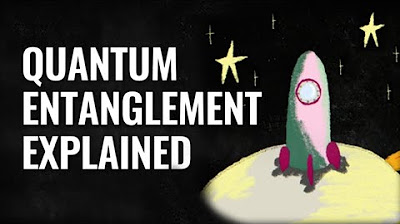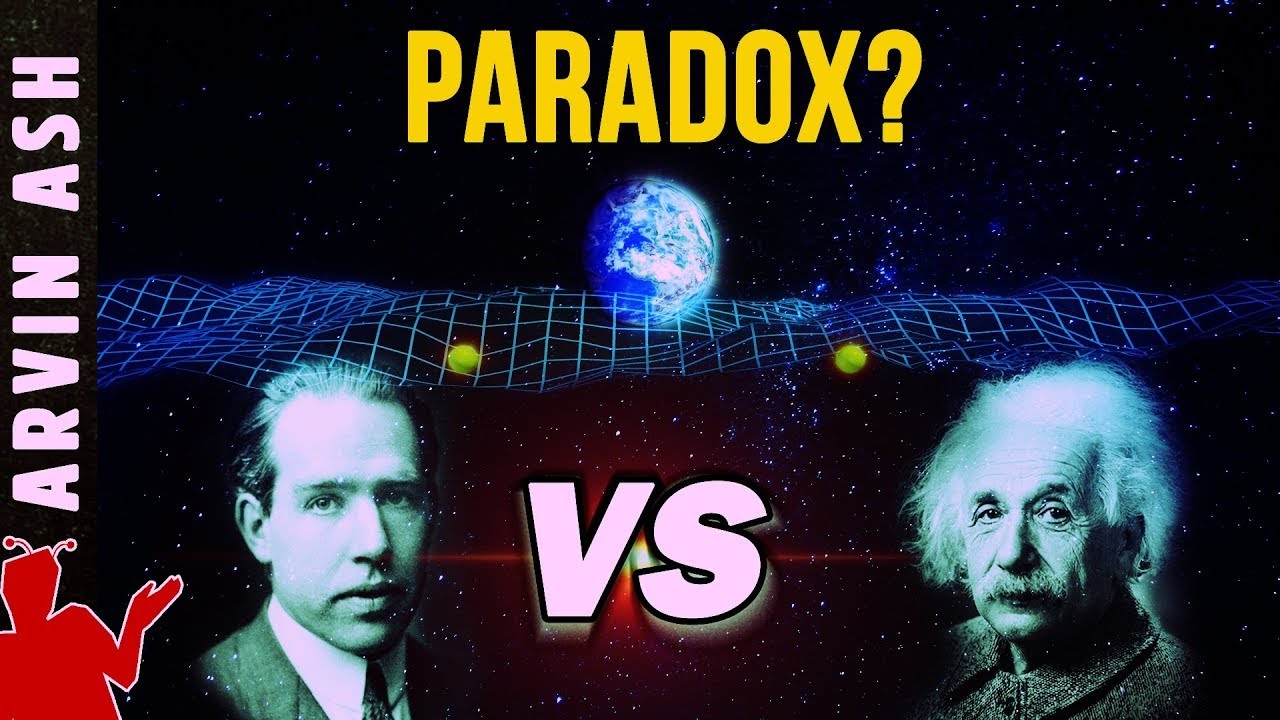Quantum Entanglement & Spooky Action at a Distance
TLDRThe script discusses Einstein's skepticism towards quantum mechanics, particularly the phenomenon of 'spooky action at a distance' where entangled particles seem to instantaneously affect each other regardless of distance. It explains the concept of particle spin and how measuring one particle instantly determines the spin of its entangled partner, despite the distance between them. The script explores the debate on whether particles have hidden information about their spin or if quantum mechanics dictates that their properties are only determined upon measurement. It highlights the famous Bell test experiment, which suggests that particles do not have predefined spins, challenging the notion of local hidden variables and supporting the non-locality of quantum mechanics. However, it clarifies that this phenomenon does not allow for faster-than-light communication, thus not violating the theory of relativity.
Takeaways
- 🌌 Einstein's Discontent - In the 1930s, Albert Einstein was not satisfied with the implications of quantum mechanics, particularly the concept of 'spooky action at a distance' which seemed to challenge the speed of light communication limit set by his theory of relativity.
- 🔄 Quantum Entanglement - The phenomenon where two or more particles become linked and the state of one instantaneously influences the state of the other, regardless of the distance separating them.
- 📏 Measurement of Spin - The spin of particles can be measured, but only in a chosen direction, resulting in two possible outcomes: spin up or spin down.
- 🤔 Probabilistic Outcomes - Measuring a particle's spin does not reveal a predefined value but instead influences the outcome, with probabilities depending on the angle of measurement.
- 💫 Conservation of Angular Momentum - The total angular momentum of the universe is conserved, which means if one particle is spin up, its entangled partner must be spin down when measured in the same direction.
- 🚫 Violation of Hidden Variable Theories - Experiments show that particles do not have pre-determined spins, contradicting the idea of hidden variables that could explain the entanglement phenomenon.
- 🔬 Bell's Theorem and Tests - John Bell proposed an experiment to test the existence of hidden information in particles. The results of these tests support the idea that no hidden information exists and the outcomes are random.
- 🌀 Randomness in Measurement - The outcomes of measuring entangled particles are random, with a 50% chance of obtaining the same or different results when two particles are entangled.
- ⚡ No Faster-than-Light Communication - Despite the instantaneous nature of entanglement, it does not allow for faster-than-light communication or information transfer, thus not violating the theory of relativity.
- 🤯 Quantum Interpretation Debate - There is ongoing debate among physicists about the interpretation of quantum mechanics and entanglement, with some believing in the non-existence of hidden information and others considering entangled particles to have instantaneous communication.
- 🌟 Einstein's Legacy - Although Einstein was troubled by the implications of quantum entanglement, the continued adherence to the principles of relativity in the face of quantum phenomena would likely have been a source of satisfaction for him.
Q & A
What was Albert Einstein's issue with quantum mechanics in the 1930s?
-Albert Einstein was upset with the concept of 'spooky action at a distance' in quantum mechanics, which suggested that an event in one part of the universe could instantaneously affect another event far away, seemingly allowing for faster-than-light communication, which contradicted his theory of relativity.
What is the property called 'spin' in fundamental particles, and does it mean the particles are physically spinning?
-Spin is a property of fundamental particles that gives them angular momentum and a certain orientation in space. However, it does not mean the particles are physically spinning in the everyday sense of rotation; the term 'spin' is used as an analogy.
How does the measurement of a particle's spin work?
-The measurement of a particle's spin involves choosing a direction to measure it against, and the outcome can only be one of two: either the particle's spin is aligned with the direction (spin up) or opposite (spin down). The act of measurement actually changes the spin of the particle to the chosen orientation.
What is the probability of getting the same spin outcome when measuring a particle's spin at a 60-degree angle from the vertical?
-The probability of getting the same spin outcome when measuring at a 60-degree angle from the vertical is 3/4 or 75% of the time for spin up, and 1/4 or 25% for spin down, based on the square of the cosine of half the angle.
What must be true about two entangled particles when measured in the same direction?
-For two entangled particles, if one is measured to have spin up, the other must have spin down when measured in the same direction. This is due to the conservation of angular momentum in the universe.
Why did Einstein prefer the idea that particles contained hidden information about their spins?
-Einstein preferred the idea of hidden information because it suggested that the particles had predetermined spins in all directions from the moment they formed, meaning no information had to travel faster than light between them, which would be consistent with his theory of relativity.
What did John Bell propose to test the idea of hidden information in particles?
-John Bell proposed an experiment with two spin detectors, each capable of measuring spin in one of three randomly selected directions, independently. By sending pairs of entangled particles to the detectors and recording the outcomes, the experiment could determine whether the particles contained hidden information or not based on the frequency of different results.
What was the experimental result that ruled out the idea of particles having hidden information?
-The experimental result showed that the outcomes of the spin measurements were different only 50% of the time, which was less than the 5/9 of the time that would be expected if the particles had hidden information. This ruled out the idea that particles contained predetermined spins in all directions.
How does quantum mechanics explain the experimental results of entangled particles?
-Quantum mechanics explains the results by stating that entangled particles do not have a well-defined spin until they are measured. The act of measurement determines the spin, and the entangled particles always yield opposite results when measured in the same direction, which is consistent with the observed 50% difference in outcomes.
What is the debate among physicists regarding the interpretation of entangled particles' behavior?
-The debate lies between those who believe that there is no hidden information in quantum particles and that spins only make sense once measured, and those who think that entangled particles can signal each other faster than light to update their states upon measurement, although this does not allow for faster-than-light communication or information transfer.
Why can't we use entangled particles to communicate faster than light, despite the 'spooky' behavior observed?
-We cannot use entangled particles to communicate faster than light because the outcomes of individual measurements are random. There is a 50/50 chance of obtaining spin up or spin down, regardless of the measurement direction or what is happening at the other detector. Only by comparing results later can it be seen that opposite spins were obtained when the same direction was measured, but this does not constitute a transfer of information faster than light.
Outlines
🌪️ Quantum Entanglement and Einstein's Dilemma
This paragraph delves into the historical context of quantum mechanics and Einstein's skepticism towards the concept of 'spooky action at a distance.' It introduces the idea of entangled particles, which are two particles that, despite being arbitrarily far apart, exhibit correlated properties when measured. The explanation covers the fundamental particle property of spin, the process of measurement affecting the particle's state, and the phenomenon of entanglement that leads to the seemingly instantaneous correlation of particle states. The paragraph also discusses Einstein's preference for an alternate explanation involving hidden information within particles, which was later challenged by John Bell's experiments.
🔍 Bell's Theorem and the Nature of Entanglement
This paragraph explores the concept of hidden variables and how John Bell proposed an experiment to test their existence within entangled particles. It explains the setup of the experiment, where two spin detectors measure particles in randomly selected directions, and how the outcomes can be used to determine whether particles have predetermined spins or not. The summary highlights the experimental results that show a 50% difference in outcomes, contradicting the idea of hidden information and supporting the quantum mechanical view of entanglement. The paragraph also discusses the implications of these findings, the debate among physicists regarding the interpretation of entanglement, and the limitations that prevent its use for faster-than-light communication, thereby not violating the theory of relativity.
Mindmap
Keywords
💡quantum mechanics
💡spooky action at a distance
💡spin
💡angular momentum
💡entanglement
💡hidden information
💡John Bell
💡relativity
💡non-locality
💡superposition
💡probability
Highlights
Albert Einstein's discontent with quantum mechanics in the 1930s.
Einstein proposed a thought experiment questioning instantaneous effects across the universe.
The concept of 'spooky action at a distance' was introduced by Einstein.
Einstein's theory of relativity ruled out faster-than-light communication.
Modern experiments confirm the 'spooky' nature of quantum mechanics.
Understanding spin is crucial to grasping the thought experiment.
Fundamental particles possess a property called spin, which is not actual spinning.
Measuring a particle's spin can only result in two outcomes: spin up or spin down.
The act of measuring a particle's spin changes its spin orientation.
The probability of a particle's spin depends on the cosine of the measurement angle.
Entangled particles are used in experiments to test quantum theory.
Entangled particles always measure opposite spins when measured in the same direction.
Quantum mechanics suggests that entangled particles don't have a well-defined spin until measured.
John Bell developed a test to determine if particles contain hidden information about their spin.
Bell's experiment uses two spin detectors capable of measuring in three different directions.
The experimental results contradict the idea of particles having hidden information about their spin.
Quantum mechanics predicts that the detectors should give different results 50% of the time.
The phenomenon is considered 'spooky' but does not allow for faster-than-light communication.
Transcripts
Browse More Related Video

Quantum 101 Episode 5: Quantum Entanglement Explained

Quantum Entanglement: Spooky Action at a Distance

Spooky Action at a Distance (Bell's Inequality) - Sixty Symbols

The EPR Paradox & Bell's inequality explained simply

Einstein's Quantum Riddle | Full Documentary | NOVA | PBS

Lecture 4 | Quantum Entanglements, Part 1 (Stanford)
5.0 / 5 (0 votes)
Thanks for rating: